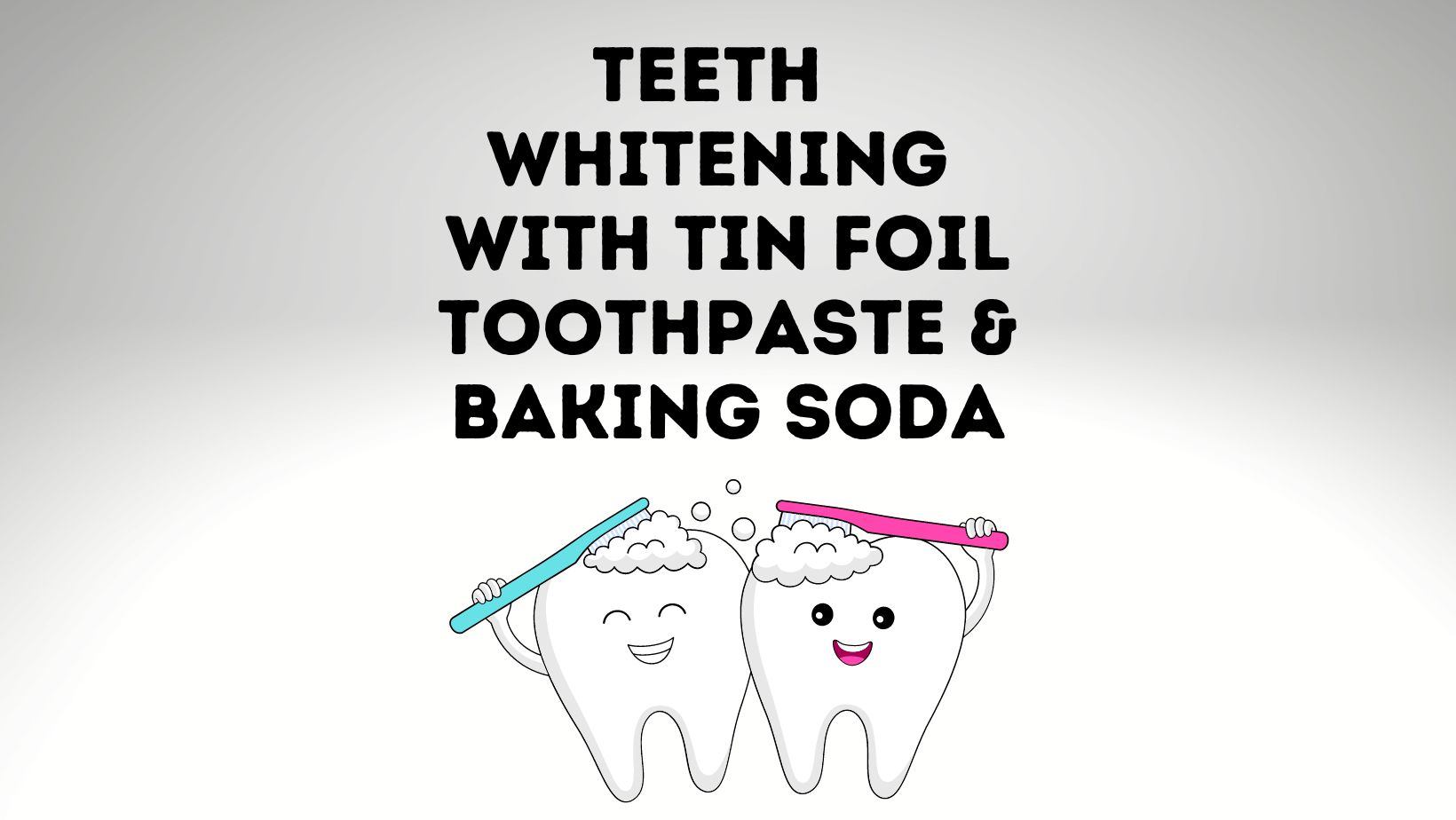
Are you tired of spending a fortune on teeth whitening treatments at the dentist? Or are you done with using those over-the-counter products that brought no benefits?
Well, you’re in luck because there are many DIY teeth whitening methods. And the best part is that you can try them at home; they’re easy and cost-effective! One of the most common and simple methods is using toothpaste. Yes, you heard it right! Toothpaste, the same dental care product in your bathroom that cleans your teeth, can also help to brighten your smile.
This article will take a closer look at how toothpaste can help whiten your teeth. In addition, you will come across some of the best toothpaste for whitening. We will also provide tips on how to get the most out of your whitening toothpaste. So, if you’re ready to say goodbye to yellow teeth and hello to a brighter, more confident smile, keep reading!
The Toothpaste, Tin Foil and Baking Soda hack for Teeth Whitening
Whitening teeth can be a hassle, but did you know that you can use household items like toothpaste, tin foil, and baking soda to achieve a brighter smile? Here’s how:
- Toothpaste: Using toothpaste specifically designed for teeth whitening can help remove surface stains and brighten your teeth. Simply brush your teeth with this toothpaste in the same manner as you would with any other toothpaste. Make sure to brush for at least two minutes, and rinse thoroughly.
- Tin Foil: This method involves wrapping tin foil around your teeth, with the shiny side facing out. Then, brush your teeth gently with a thin layer of baking soda over the foil. This method works by reflecting light onto your teeth and helping to remove surface stains.
- Baking Soda: Baking soda has natural whitening properties and can be used on its own or in combination with toothpaste or hydrogen peroxide. Simply mix baking soda with a small amount of water to create a paste, and brush your teeth with it for two minutes. Rinse thoroughly and repeat once a week for best results.
It’s important to note that these methods should be used in moderation, as overuse can cause damage to your teeth and gums. It’s always best to consult with a dental professional before trying any new teeth whitening methods.
Or
- Mix one teaspoon of Baking Soda in a glass bowl and one tablespoon of toothpaste together.
- Apply half of this mixture all over your teeth and half of it on aluminum foil. Wrap the foil around your teeth. The process is very easy but can be slightly messy.
- Let the mixture and aluminum stay on your teeth for an hour. Until then, avoid gulping down your saliva. Specifically, avoid ingesting Baking Soda and Toothpaste.
- After an hour, remove the aluminum foil, use a dry brush, and clean your teeth nicely. Wash your mouth with plain water as well.
You can follow the said remedy twice a week for better results. However, avoid repeating the hack too often, or you will damage your teeth’ enamel.
Downsides of Whitening your Teeth with Tin Foil, Toothpaste and Baking Soda
- It may end up with ineffective results: The toothpaste, tin foil, and baking soda hack is not a scientifically proven method for teeth whitening. It may not provide the desired results and can even harm your teeth.
- It may lead to tooth sensitivity: Using tin foil to cover the teeth can cause tooth sensitivity as it can expose the enamel and nerves, leading to discomfort and pain.
- It can prove harmful to tooth enamel: Baking soda is a highly abrasive substance that can erode the enamel, leaving your teeth more susceptible to cavities and sensitivity.
- It may damage gums: The tin foil used in this hack can cause injury to the gums and soft tissues of the mouth, leading to inflammation and irritation.
- It might lead to a lack of regulation: This hack is not regulated by any governing body, which means there is no control over the quality of ingredients used. The ingredients used may not be safe for human consumption.
- The poor quality of ingredients can be harmful: There is no guarantee that the toothpaste, tin foil, and baking soda used are of high quality and free of harmful chemicals.
- No professional supervision can be harmful: This hack is done at home without professional supervision, increasing the chances of mistakes and adverse effects.
- It is not sustainable: This hack may provide temporary results, but it is not a sustainable solution for long-term teeth whitening.
- The risk of overuse is always there: Overusing this hack can cause significant damage to the teeth and gums. It is important to be mindful of the frequency and duration of use.
7 Effective and Proven Hacks for Teeth Whitening at Home
- Baking Soda and Lemon Juice
Mix equal parts of baking soda and lemon juice to form a paste. Brush your teeth with this mixture for 2 minutes and rinse thoroughly. Repeat this process once a week for the best results.
- Apple Cider Vinegar
Dilute apple cider vinegar with water and use it as a mouthwash. Rinse for 1 minute, then rinse with water. This process can be repeated daily for optimal results.
- Activated Charcoal
Purchase activated charcoal in powder form and brush your teeth with it. Rinse thoroughly after 2 minutes. This process can be repeated once a week for the best results.
- Hydrogen Peroxide
Mix equal parts of hydrogen peroxide and water to form a mouthwash. Rinse for 1 minute, then rinse with water. Repeat daily for best results.
- Oil Pulling
Swish a tablespoon of oil (coconut, sesame, or olive) in your mouth for 15-20 minutes, then rinse with water. Repeat daily for optimal results.
- Strawberries
Mash strawberries and brush them onto your teeth, leaving them on for 5 minutes. Rinse thoroughly. Repeat once a week for best results.
- Reduce Staining Foods and Drinks
Reduce or eliminate consumption of darkly pigmented foods and drinks such as coffee, tea, red wine, and tobacco.
Remember to always brush your teeth twice a day and floss daily for overall oral health and to maintain any teeth whitening results.
But are our teeth meant to stay sparkling white always?
No, human teeth are not meant to stay sparkling white. Teeth naturally have a slightly yellow or off-white color due to the underlying dentin and the outer enamel layer. Over time, enamel can become thinner and expose more of the yellow dentin, causing teeth to look yellow or stained.
There are several factors that can contribute to teeth staining and yellowing. These factors may include aging, genetics, lifestyle choices, and certain medical conditions. Consuming darkly pigmented foods and drinks, smoking, and poor oral hygiene can all lead to yellowing and staining of the teeth.
While some people may have naturally whiter teeth, it is not normal for teeth to be blindingly white. If you are concerned about the color of your teeth, consult with a dentist to determine. They may be able to suggest to you the best course of action. In some cases, professional teeth whitening treatments may be recommended.
In addition, stay committed to maintaining good oral hygiene. Besides that, limit staining habits to keep your teeth as white as possible. Regular brushing and flossing and avoiding staining foods and drinks can help keep your teeth looking their best.

Hi, This is Lyn, I suffer from dental sensitivity for a very long time. PowerToothpaste.com is where I share my views of various toothpaste brands, along with tips on how to use toothpaste and what to look for when purchasing.
